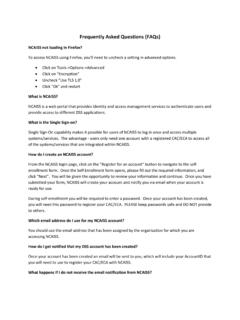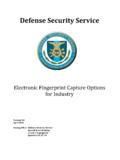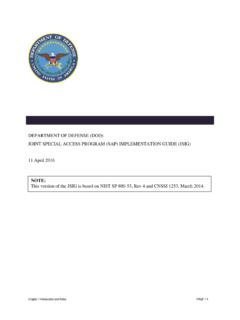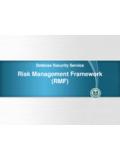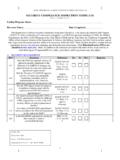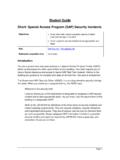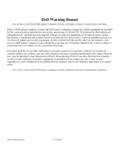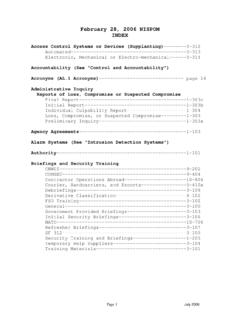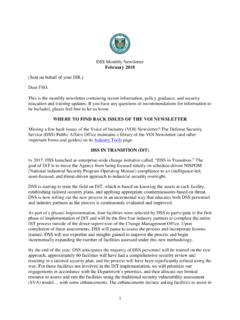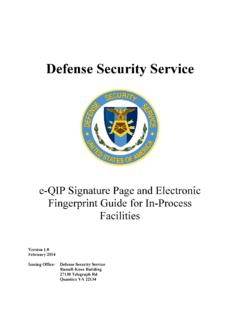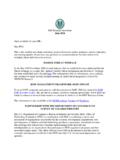Transcription of NCMS 2016 FAQs - Defense Security Service (DSS)
1 NCMS 2016 faqs 1. Will the NAO presentations be posted on the external DSS website and/or the NCMS website? Where can the Risk Management Framework (RMF) supporting artifacts located? a. DSS has posted the content of the NAO presentations on our external DSS. website on the Risk Management Framework Information and Resource page. 2. When is the RMF transition expected to be complete? a. It is anticipated that the NISP RMF transition will be completed by February 2018. 3. What is required to support the Risk Assessment?
2 Risk assessments are a key part of effective risk management and facilitate decision making throughout the system life cycle. There are no specific requirements with regard to the formality or level of detail to any risk assessment. Organizations have maximum flexibility on how to conduct risk assessment and are encouraged to follow NIST guidance in coordination with GCA, DSS. representatives and corporate staff. 4. How are we preparing for Regional inconsistencies? a. We are addressing probable inconsistencies through training, transparency, internal and external stakeholder meetings, and working groups.
3 5. What is the classification level of the Risk Assessment Report? a. Industry is instructed to follow the appropriate Security Classification Guides (SCGs). 6. Will we require a separate Security Control Traceability Matrix (SCTM)? a. No. The selected controls will be identified within the System Security Plan (SSP). 7. Does DSS have a guide that compares NISPOM and RMF controls? a. Yes. DSS has created a control mapping document that is located on our Risk Management Framework Information and Resource page. 8. Can a risk assessment be used for each program?
4 Yes, as long as the organizational RA considers the program specific risk and associated threats to the program. 9. Please provide clarification on RMF Timeline. a. When DSS receives a complete and accurate System Security Plan (SSP) with a certification statement and all required supporting artifacts, our goal is to complete authorization actions within 30 days which commences upon receipt of the SSP. b. At Step Two of the RMF Process, our goal is to review submitted artifacts and return to the submitter within 5-10 days.
5 10. In reference to the timelines, is it 30 Calendar Days or 30 Business Days? NCMS faqs prepared by DSS/NAO 07/27/ 2016 . a. The timelines refer to Calendar Days. 11. Are we required to follow the DISA Security Technical Implementation Guides (STIG)? a. Yes. DSS will utilize the technical DISA STIGs and associated benchmarks to evaluate technical compliance to the controls (M-L-L) within the System Security Plan (SSP). GCA contractual requirements or Memorandum of Understanding/Agreements may impose compliance to Federal or other baseline requirements which will be documented in the SSP as appropriate.
6 12. Has DSS formally adopted the DISA Security Technical Implementation Guides (STIGS) as industry's system configuration guidance? Will DSS require the use of the SCAP Compliance Checker to test the Security posture of various operating systems? How should the SCAP results be handled? Are they classified? a. DSS will utilize the DISA STIGs and associated benchmarks to evaluate technical compliance to the controls (M-L-L) within the System Security Plan (SSP). During the on-site technical assessment, ISSMs and ISSPs will utilize the SCAP.
7 Protocol, appropriate benchmark and STIG viewer to evaluate results. If a Security Classification Guide (SCG) provides certain information deemed classified ( vulnerabilities/weaknesses), the ISSM will store and protect the results from unauthorized access on the system (including POA&Ms). 13. What version of the DISA's STIGS and SCAP Compliance Checker should be used? a. Visit DISA or NIST's websites in order to verify the current version of the SCAP. Compliance Checker, STIG Viewer, and Operating System Baselines.
8 The NIST. baselines and checklists are located here. 14. Will the new process manual (DSS Assessment and Authorization Manual Process Manual (DAAPM)) address both NISPOM Conforming Change 2 and Risk Management Framework (RMF)? a. On May 18, 2016 , the Department of Defense published Change 2 to DoD. , National Industrial Security Operating Manual (NISPOM).. NISPOM Change 2 provides guidance for Insider Threat activities and requires cleared contractors to follow Cognizant Security Agencies (CSA) guidance that is based on section 3541, et seq.
9 Of title 44, , also known as the Federal Information Security Management Act, National Institute of Standards and Technology Special Publication (NIST) 800-37, Committee on National Security Systems (CNSS) Directive 504, and other applicable publications ( NIST SP. 800-53 and CNNSI No. 1253. In response to this policy change, and as the CSO. for DoD, the DSS will publish RMF guidance in the DAAPM and its associated templates, tools, and guides. 15. What needs to be documented in the Hardware Baseline? Does the keyboard need to be documented?)
10 NCMS faqs prepared by DSS/NAO 07/27/ 2016 . a. Your Hardware Baseline should include all the Security relevant components of your information system. In particular, your Hardware Baseline should contain all the equipment with non-volatile memory that will process or retain classified information. A standard keyboard does not possess non-volatile memory. Therefore, it does not need to be included in your Hardware Baseline. 16. If a different version of software is used on an information system, will the ISSM. lose Type Authorization?
